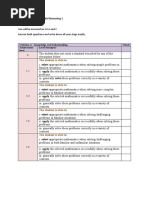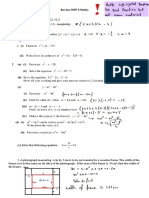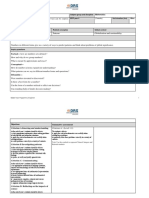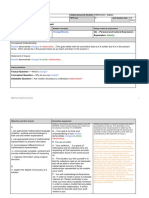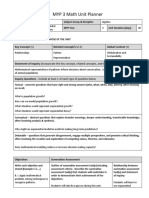9 15 2016 1 1 2 Investigating The Growth of Patterns
Uploaded by
api-327140356Copyright:
Available Formats
9 15 2016 1 1 2 Investigating The Growth of Patterns
Uploaded by
api-327140356Original Title
Copyright
Available Formats
Share this document
Did you find this document useful?
Is this content inappropriate?
Copyright:
Available Formats
9 15 2016 1 1 2 Investigating The Growth of Patterns
Uploaded by
api-327140356Copyright:
Available Formats
1.1.
2 Investigating the Growth of Patterns
Learning Target: I can collect and analyze data with tables and graphs.
How a pattern grows is a major focus of this course. Understanding how something
changes can help you make decisions and predict the future. Today you will work in
your groups to analyze situations that involve different types of functions. Data is
given below for three different situations.
SITUATION #1: HOT TUB DESIGN
Width of Hot Tub
Length of Hot Tub
1
36
2
18
3
12
4
9
6
6
9
4
12
3
18
2
36
1
6
145
8
7
437
4
7
35
8
40
SITUATION #2: LOCAL CRISIS
Day
# of Infected People
0
2
1
6
2
18
3
54
4
162
5
468
SITUATION #3: TIMED SIGNATURE
# of Signatures
Time (in seconds)
0
0
1
5
Using the data above plot the
points for each situation on the set
of axes provided. Note that some
data points may not fit on the given
axes. Then describe each graph.
As you write your descriptions,
answer the following questions:
1. What does each graph look like?
2. Should the points be connected?
SITUATION #1: HOT TUB DESIGN
Describe the graph:
2
10
3
15
4
20
5
25
6
30
SITUATION #2: LOCAL CRISIS
SITUATION #3: TIMED SIGNATURE
Graphs and tables not only represent data, but they also allow you to answer
questions about the data. Use your tables and graphs to answer the
questions below.
a) Which data appears to be linear? That is, when graphed, which data forms a
line? Explain why it makes sense for this situation to have a linear graph.
b) The town of Parsnipville will have a flu vaccine available on Day 7. Only
people who have not yet gotten the flu will need to be vaccinated. Since the
town has 3800, how many people will need the vaccine on that day? Is it
easier to answer this question with your graph or with your table? Explain.
Describe the graph:
Describe the graph:
____________________________________________________________________
Now that youve plotted the points for each graph, find the point where x = 4 and
label it with its coordinate. Then explain what that point represents in each
situation.
c) Now that Perry knows his options for the design of his hot tub, he wants to
pick the hot tub that has the smallest perimeter. What do you recommend?
Situation #1: The point (4, _____) represents _______________________________
___________________________________________________________________.
Situation #2: The point (4, _____) represents _______________________________
___________________________________________________________________.
Situation #3: The point (4, _____) represents _______________________________
___________________________________________________________________.
d) Why isnt there a point when x = 0 on your graph for Lab A? Could there be?
Explain.
You might also like
- MYP5S - Modeling An Infectious Disease (BCD)No ratings yetMYP5S - Modeling An Infectious Disease (BCD)6 pages
- Additional Mathematics Scheme of Work Form 4 (2012)100% (3)Additional Mathematics Scheme of Work Form 4 (2012)24 pages
- MYP5E - Visiting the Statue of Liberty (CD)No ratings yetMYP5E - Visiting the Statue of Liberty (CD)10 pages
- 9 13 2016 1 1 1 Solving Puzzles in TeamsNo ratings yet9 13 2016 1 1 1 Solving Puzzles in Teams2 pages
- IDU Music Theory & Mathematics Formative Assessment 1 Grade 6No ratings yetIDU Music Theory & Mathematics Formative Assessment 1 Grade 63 pages
- Ib Mathematics Internal Assessment Student Handout: Ellen Thompson Updated May 2020No ratings yetIb Mathematics Internal Assessment Student Handout: Ellen Thompson Updated May 202020 pages
- Knowing Come Together To Give Us Our Mathematical Body of KnowledgeNo ratings yetKnowing Come Together To Give Us Our Mathematical Body of Knowledge10 pages
- Statistics Paper 2 Practice: Price ($) Number of BooksNo ratings yetStatistics Paper 2 Practice: Price ($) Number of Books5 pages
- M23 Extended Mathematics Markscheme English 1No ratings yetM23 Extended Mathematics Markscheme English 130 pages
- Factoring and Quadratics: 8.2, 9.2, 11.2: Review MYP 5 MathsNo ratings yetFactoring and Quadratics: 8.2, 9.2, 11.2: Review MYP 5 Maths20 pages
- IB Math AI HL - Practice Exams - Mock Exams Set 9 Paper 2No ratings yetIB Math AI HL - Practice Exams - Mock Exams Set 9 Paper 215 pages
- A Novel Accurate Adaptive Constant On-Time Buck Converter For A Wide-Range OperationNo ratings yetA Novel Accurate Adaptive Constant On-Time Buck Converter For A Wide-Range Operation11 pages
- MYP Unit Planner: Stage 1 - Establishing The Purpose of The UnitNo ratings yetMYP Unit Planner: Stage 1 - Establishing The Purpose of The Unit7 pages
- Al-Serkal Naser Bin Jassim - Bivariate Data Formative Assessment 2 9cNo ratings yetAl-Serkal Naser Bin Jassim - Bivariate Data Formative Assessment 2 9c4 pages
- Quadratic Inequalities: Jocelyn D. IsipNo ratings yetQuadratic Inequalities: Jocelyn D. Isip17 pages
- Australian International School, Dhaka: Formative Assessment - 2 20-21 Term 1 MYP 4 (Year 9) Subject: - MathematicsNo ratings yetAustralian International School, Dhaka: Formative Assessment - 2 20-21 Term 1 MYP 4 (Year 9) Subject: - Mathematics11 pages
- I - S and Maths Grade 7 IDU Unit PlannerNo ratings yetI - S and Maths Grade 7 IDU Unit Planner9 pages
- Assessment 28 of 100 Rational Functions - HL - AA and AI Old Math HL - From Prof IyerNo ratings yetAssessment 28 of 100 Rational Functions - HL - AA and AI Old Math HL - From Prof Iyer11 pages
- M21 Integrated Humanities (English) MarkschemeNo ratings yetM21 Integrated Humanities (English) Markscheme29 pages
- MYP 3 Unit Planner - Exponential FunctionsNo ratings yetMYP 3 Unit Planner - Exponential Functions4 pages
- Course Overviews MYP Mathematics, UWC Thailand 2022-2023: Processes SolutionsNo ratings yetCourse Overviews MYP Mathematics, UWC Thailand 2022-2023: Processes Solutions9 pages
- Extended - Mathematics - Markscheme May 2016No ratings yetExtended - Mathematics - Markscheme May 201624 pages
- What Is Less Than Nothing - Unit Planner 2022-2023No ratings yetWhat Is Less Than Nothing - Unit Planner 2022-20235 pages
- Unit Plan #1: Accentuate The Negative Grade 7: Colorado Prepared GraduatesNo ratings yetUnit Plan #1: Accentuate The Negative Grade 7: Colorado Prepared Graduates11 pages
- Ib Math Applications and Interpretations Summer PacketNo ratings yetIb Math Applications and Interpretations Summer Packet21 pages
- Ib Math Analysis Approaches Summer PacketNo ratings yetIb Math Analysis Approaches Summer Packet6 pages
- 9 23 2016 Asymptotes Summary Statements Linear RelationshipsNo ratings yet9 23 2016 Asymptotes Summary Statements Linear Relationships2 pages
- 9 22 2016 1 2 2-1 2 3 Absolute Value Function MachinesNo ratings yet9 22 2016 1 2 2-1 2 3 Absolute Value Function Machines3 pages
- 9 14 2016 Using A Graphing Calculator To Explore A Function 1-10No ratings yet9 14 2016 Using A Graphing Calculator To Explore A Function 1-103 pages
